Role of Nurses in Health Promotion Strategies for Diabetes Mellitus
VerifiedAdded on 2023/03/17
|8
|2357
|50
AI Summary
This essay explores the role of nurses in the five major strategies of the Ottawa Charter for health promotion, specifically in addressing diabetes mellitus. It discusses the strategies of building healthy public policy, creating supportive environments, developing personal skills, strengthening community actions, and reorienting health services. The essay emphasizes the importance of nurses in promoting health and preventing diabetes.
Contribute Materials
Your contribution can guide someone’s learning journey. Share your
documents today.
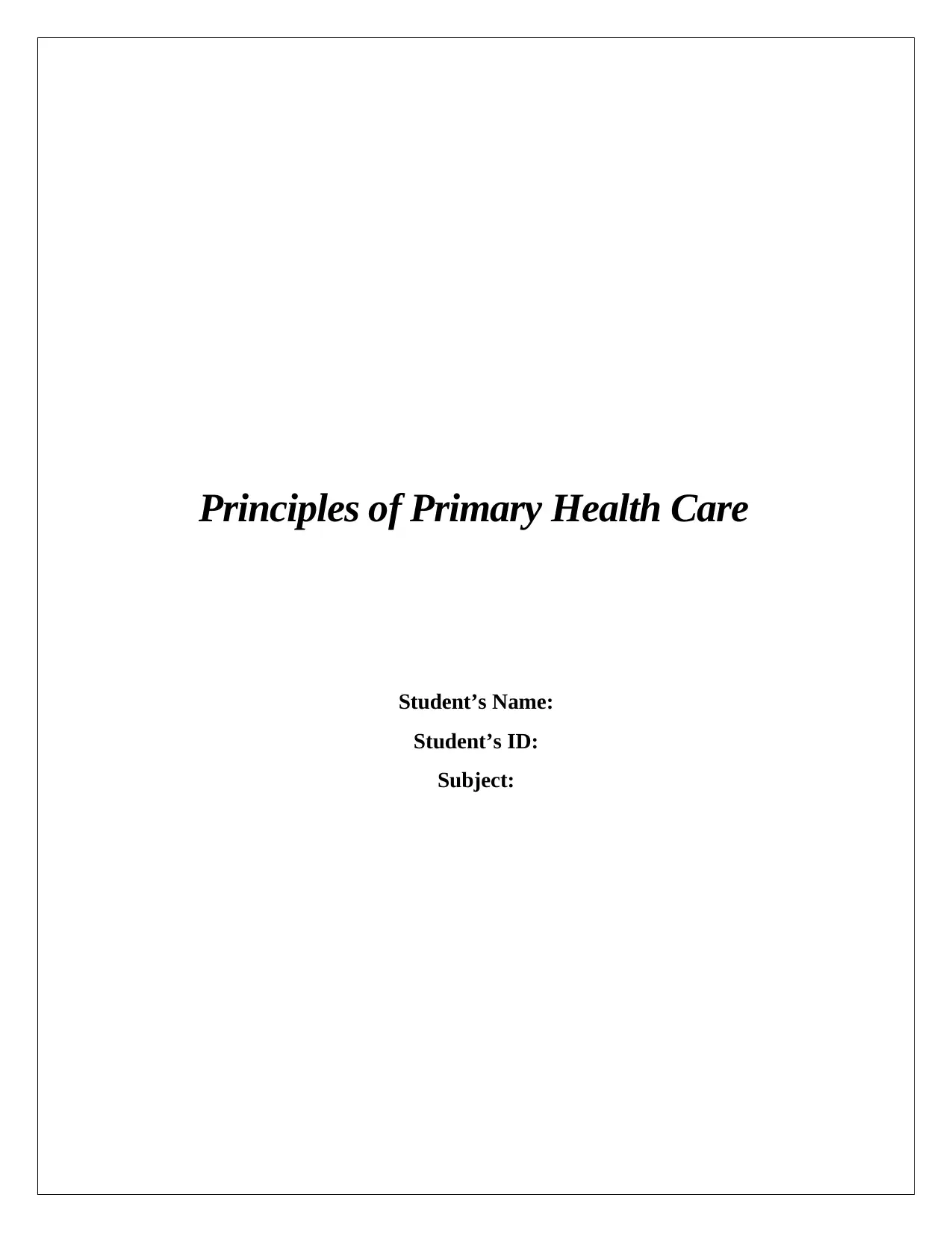
Principles of Primary Health Care
Student’s Name:
Student’s ID:
Subject:
Student’s Name:
Student’s ID:
Subject:
Secure Best Marks with AI Grader
Need help grading? Try our AI Grader for instant feedback on your assignments.
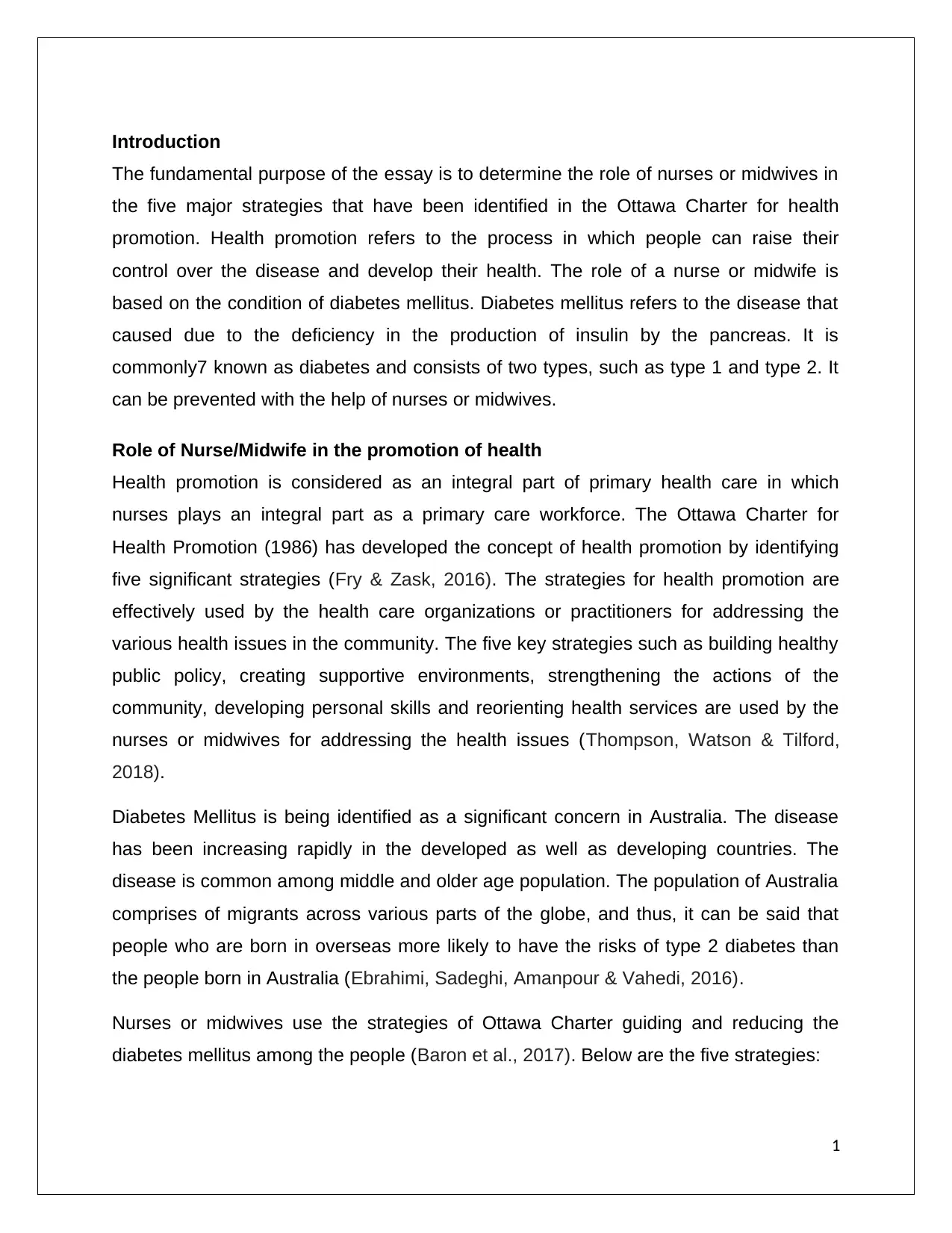
Introduction
The fundamental purpose of the essay is to determine the role of nurses or midwives in
the five major strategies that have been identified in the Ottawa Charter for health
promotion. Health promotion refers to the process in which people can raise their
control over the disease and develop their health. The role of a nurse or midwife is
based on the condition of diabetes mellitus. Diabetes mellitus refers to the disease that
caused due to the deficiency in the production of insulin by the pancreas. It is
commonly7 known as diabetes and consists of two types, such as type 1 and type 2. It
can be prevented with the help of nurses or midwives.
Role of Nurse/Midwife in the promotion of health
Health promotion is considered as an integral part of primary health care in which
nurses plays an integral part as a primary care workforce. The Ottawa Charter for
Health Promotion (1986) has developed the concept of health promotion by identifying
five significant strategies (Fry & Zask, 2016). The strategies for health promotion are
effectively used by the health care organizations or practitioners for addressing the
various health issues in the community. The five key strategies such as building healthy
public policy, creating supportive environments, strengthening the actions of the
community, developing personal skills and reorienting health services are used by the
nurses or midwives for addressing the health issues (Thompson, Watson & Tilford,
2018).
Diabetes Mellitus is being identified as a significant concern in Australia. The disease
has been increasing rapidly in the developed as well as developing countries. The
disease is common among middle and older age population. The population of Australia
comprises of migrants across various parts of the globe, and thus, it can be said that
people who are born in overseas more likely to have the risks of type 2 diabetes than
the people born in Australia (Ebrahimi, Sadeghi, Amanpour & Vahedi, 2016).
Nurses or midwives use the strategies of Ottawa Charter guiding and reducing the
diabetes mellitus among the people (Baron et al., 2017). Below are the five strategies:
1
The fundamental purpose of the essay is to determine the role of nurses or midwives in
the five major strategies that have been identified in the Ottawa Charter for health
promotion. Health promotion refers to the process in which people can raise their
control over the disease and develop their health. The role of a nurse or midwife is
based on the condition of diabetes mellitus. Diabetes mellitus refers to the disease that
caused due to the deficiency in the production of insulin by the pancreas. It is
commonly7 known as diabetes and consists of two types, such as type 1 and type 2. It
can be prevented with the help of nurses or midwives.
Role of Nurse/Midwife in the promotion of health
Health promotion is considered as an integral part of primary health care in which
nurses plays an integral part as a primary care workforce. The Ottawa Charter for
Health Promotion (1986) has developed the concept of health promotion by identifying
five significant strategies (Fry & Zask, 2016). The strategies for health promotion are
effectively used by the health care organizations or practitioners for addressing the
various health issues in the community. The five key strategies such as building healthy
public policy, creating supportive environments, strengthening the actions of the
community, developing personal skills and reorienting health services are used by the
nurses or midwives for addressing the health issues (Thompson, Watson & Tilford,
2018).
Diabetes Mellitus is being identified as a significant concern in Australia. The disease
has been increasing rapidly in the developed as well as developing countries. The
disease is common among middle and older age population. The population of Australia
comprises of migrants across various parts of the globe, and thus, it can be said that
people who are born in overseas more likely to have the risks of type 2 diabetes than
the people born in Australia (Ebrahimi, Sadeghi, Amanpour & Vahedi, 2016).
Nurses or midwives use the strategies of Ottawa Charter guiding and reducing the
diabetes mellitus among the people (Baron et al., 2017). Below are the five strategies:
1
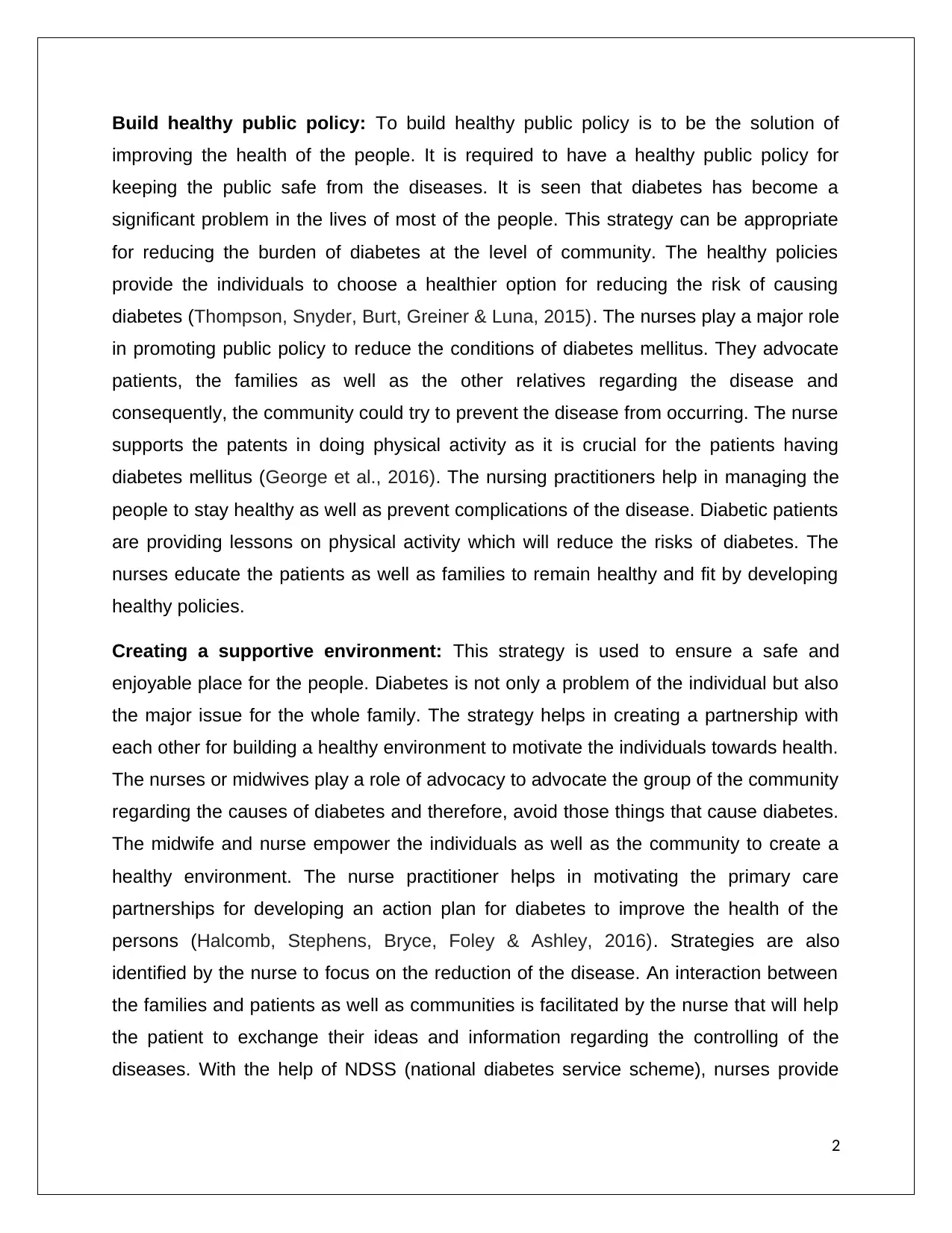
Build healthy public policy: To build healthy public policy is to be the solution of
improving the health of the people. It is required to have a healthy public policy for
keeping the public safe from the diseases. It is seen that diabetes has become a
significant problem in the lives of most of the people. This strategy can be appropriate
for reducing the burden of diabetes at the level of community. The healthy policies
provide the individuals to choose a healthier option for reducing the risk of causing
diabetes (Thompson, Snyder, Burt, Greiner & Luna, 2015). The nurses play a major role
in promoting public policy to reduce the conditions of diabetes mellitus. They advocate
patients, the families as well as the other relatives regarding the disease and
consequently, the community could try to prevent the disease from occurring. The nurse
supports the patents in doing physical activity as it is crucial for the patients having
diabetes mellitus (George et al., 2016). The nursing practitioners help in managing the
people to stay healthy as well as prevent complications of the disease. Diabetic patients
are providing lessons on physical activity which will reduce the risks of diabetes. The
nurses educate the patients as well as families to remain healthy and fit by developing
healthy policies.
Creating a supportive environment: This strategy is used to ensure a safe and
enjoyable place for the people. Diabetes is not only a problem of the individual but also
the major issue for the whole family. The strategy helps in creating a partnership with
each other for building a healthy environment to motivate the individuals towards health.
The nurses or midwives play a role of advocacy to advocate the group of the community
regarding the causes of diabetes and therefore, avoid those things that cause diabetes.
The midwife and nurse empower the individuals as well as the community to create a
healthy environment. The nurse practitioner helps in motivating the primary care
partnerships for developing an action plan for diabetes to improve the health of the
persons (Halcomb, Stephens, Bryce, Foley & Ashley, 2016). Strategies are also
identified by the nurse to focus on the reduction of the disease. An interaction between
the families and patients as well as communities is facilitated by the nurse that will help
the patient to exchange their ideas and information regarding the controlling of the
diseases. With the help of NDSS (national diabetes service scheme), nurses provide
2
improving the health of the people. It is required to have a healthy public policy for
keeping the public safe from the diseases. It is seen that diabetes has become a
significant problem in the lives of most of the people. This strategy can be appropriate
for reducing the burden of diabetes at the level of community. The healthy policies
provide the individuals to choose a healthier option for reducing the risk of causing
diabetes (Thompson, Snyder, Burt, Greiner & Luna, 2015). The nurses play a major role
in promoting public policy to reduce the conditions of diabetes mellitus. They advocate
patients, the families as well as the other relatives regarding the disease and
consequently, the community could try to prevent the disease from occurring. The nurse
supports the patents in doing physical activity as it is crucial for the patients having
diabetes mellitus (George et al., 2016). The nursing practitioners help in managing the
people to stay healthy as well as prevent complications of the disease. Diabetic patients
are providing lessons on physical activity which will reduce the risks of diabetes. The
nurses educate the patients as well as families to remain healthy and fit by developing
healthy policies.
Creating a supportive environment: This strategy is used to ensure a safe and
enjoyable place for the people. Diabetes is not only a problem of the individual but also
the major issue for the whole family. The strategy helps in creating a partnership with
each other for building a healthy environment to motivate the individuals towards health.
The nurses or midwives play a role of advocacy to advocate the group of the community
regarding the causes of diabetes and therefore, avoid those things that cause diabetes.
The midwife and nurse empower the individuals as well as the community to create a
healthy environment. The nurse practitioner helps in motivating the primary care
partnerships for developing an action plan for diabetes to improve the health of the
persons (Halcomb, Stephens, Bryce, Foley & Ashley, 2016). Strategies are also
identified by the nurse to focus on the reduction of the disease. An interaction between
the families and patients as well as communities is facilitated by the nurse that will help
the patient to exchange their ideas and information regarding the controlling of the
diseases. With the help of NDSS (national diabetes service scheme), nurses provide
2
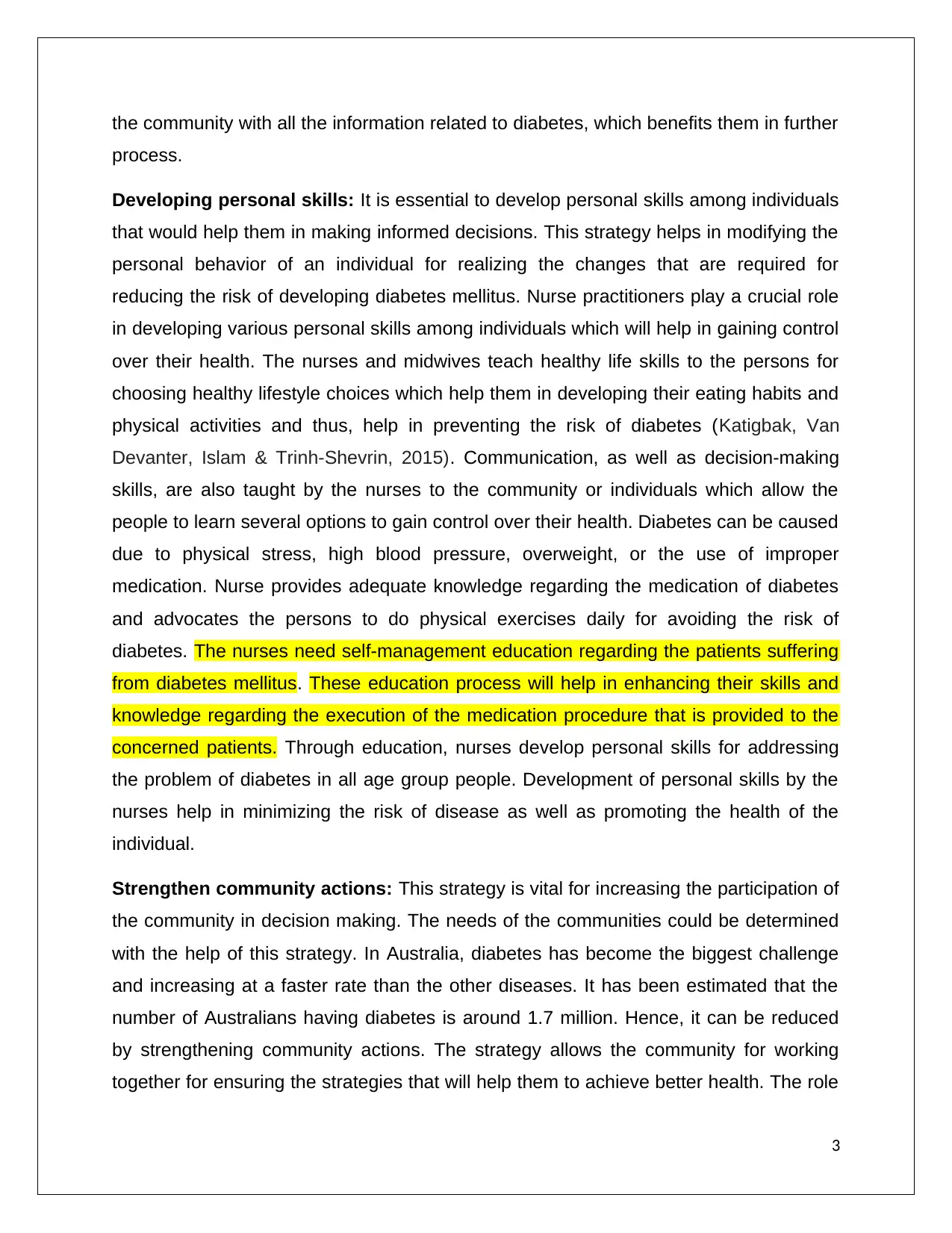
the community with all the information related to diabetes, which benefits them in further
process.
Developing personal skills: It is essential to develop personal skills among individuals
that would help them in making informed decisions. This strategy helps in modifying the
personal behavior of an individual for realizing the changes that are required for
reducing the risk of developing diabetes mellitus. Nurse practitioners play a crucial role
in developing various personal skills among individuals which will help in gaining control
over their health. The nurses and midwives teach healthy life skills to the persons for
choosing healthy lifestyle choices which help them in developing their eating habits and
physical activities and thus, help in preventing the risk of diabetes (Katigbak, Van
Devanter, Islam & Trinh-Shevrin, 2015). Communication, as well as decision-making
skills, are also taught by the nurses to the community or individuals which allow the
people to learn several options to gain control over their health. Diabetes can be caused
due to physical stress, high blood pressure, overweight, or the use of improper
medication. Nurse provides adequate knowledge regarding the medication of diabetes
and advocates the persons to do physical exercises daily for avoiding the risk of
diabetes. The nurses need self-management education regarding the patients suffering
from diabetes mellitus. These education process will help in enhancing their skills and
knowledge regarding the execution of the medication procedure that is provided to the
concerned patients. Through education, nurses develop personal skills for addressing
the problem of diabetes in all age group people. Development of personal skills by the
nurses help in minimizing the risk of disease as well as promoting the health of the
individual.
Strengthen community actions: This strategy is vital for increasing the participation of
the community in decision making. The needs of the communities could be determined
with the help of this strategy. In Australia, diabetes has become the biggest challenge
and increasing at a faster rate than the other diseases. It has been estimated that the
number of Australians having diabetes is around 1.7 million. Hence, it can be reduced
by strengthening community actions. The strategy allows the community for working
together for ensuring the strategies that will help them to achieve better health. The role
3
process.
Developing personal skills: It is essential to develop personal skills among individuals
that would help them in making informed decisions. This strategy helps in modifying the
personal behavior of an individual for realizing the changes that are required for
reducing the risk of developing diabetes mellitus. Nurse practitioners play a crucial role
in developing various personal skills among individuals which will help in gaining control
over their health. The nurses and midwives teach healthy life skills to the persons for
choosing healthy lifestyle choices which help them in developing their eating habits and
physical activities and thus, help in preventing the risk of diabetes (Katigbak, Van
Devanter, Islam & Trinh-Shevrin, 2015). Communication, as well as decision-making
skills, are also taught by the nurses to the community or individuals which allow the
people to learn several options to gain control over their health. Diabetes can be caused
due to physical stress, high blood pressure, overweight, or the use of improper
medication. Nurse provides adequate knowledge regarding the medication of diabetes
and advocates the persons to do physical exercises daily for avoiding the risk of
diabetes. The nurses need self-management education regarding the patients suffering
from diabetes mellitus. These education process will help in enhancing their skills and
knowledge regarding the execution of the medication procedure that is provided to the
concerned patients. Through education, nurses develop personal skills for addressing
the problem of diabetes in all age group people. Development of personal skills by the
nurses help in minimizing the risk of disease as well as promoting the health of the
individual.
Strengthen community actions: This strategy is vital for increasing the participation of
the community in decision making. The needs of the communities could be determined
with the help of this strategy. In Australia, diabetes has become the biggest challenge
and increasing at a faster rate than the other diseases. It has been estimated that the
number of Australians having diabetes is around 1.7 million. Hence, it can be reduced
by strengthening community actions. The strategy allows the community for working
together for ensuring the strategies that will help them to achieve better health. The role
3
Secure Best Marks with AI Grader
Need help grading? Try our AI Grader for instant feedback on your assignments.
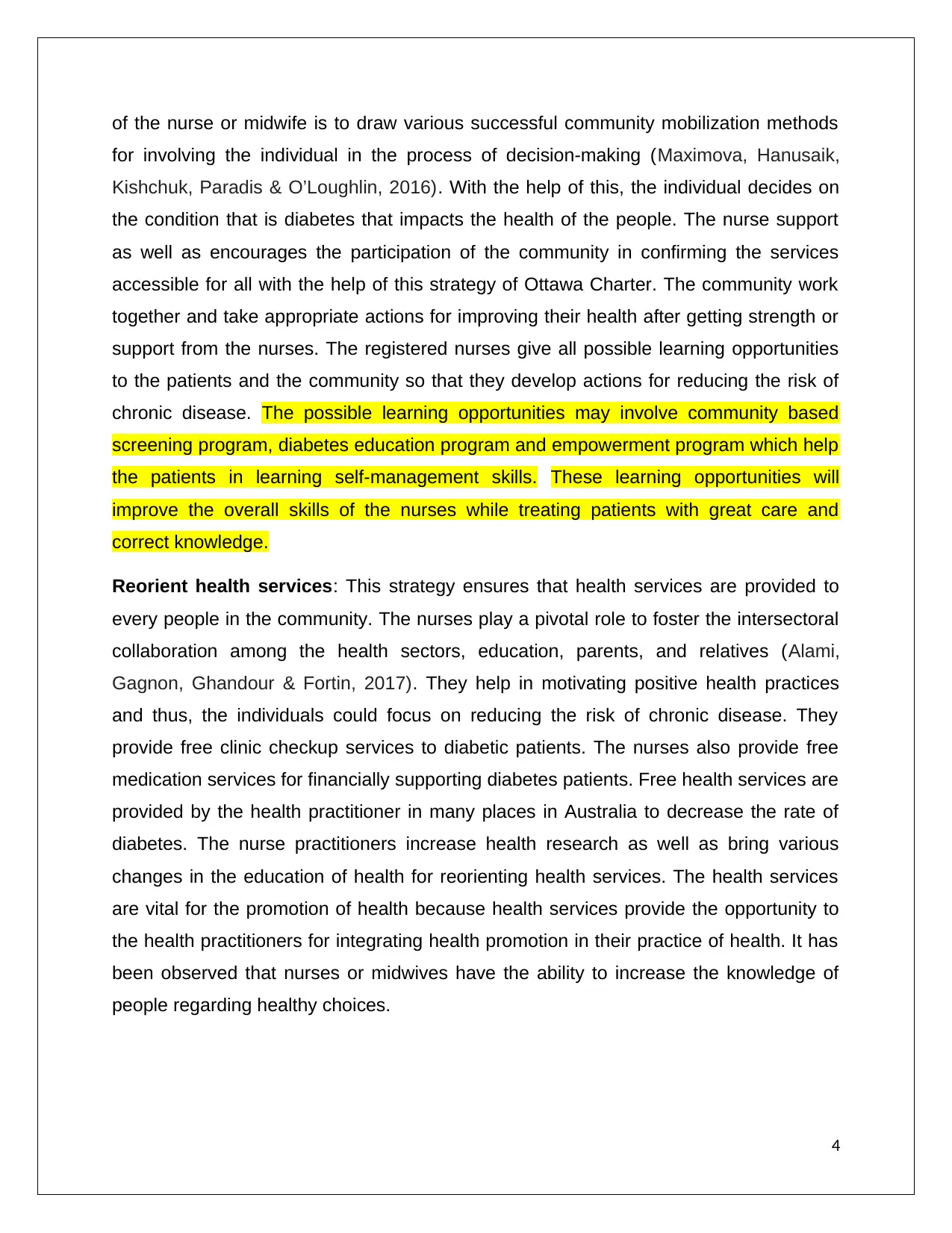
of the nurse or midwife is to draw various successful community mobilization methods
for involving the individual in the process of decision-making (Maximova, Hanusaik,
Kishchuk, Paradis & O’Loughlin, 2016). With the help of this, the individual decides on
the condition that is diabetes that impacts the health of the people. The nurse support
as well as encourages the participation of the community in confirming the services
accessible for all with the help of this strategy of Ottawa Charter. The community work
together and take appropriate actions for improving their health after getting strength or
support from the nurses. The registered nurses give all possible learning opportunities
to the patients and the community so that they develop actions for reducing the risk of
chronic disease. The possible learning opportunities may involve community based
screening program, diabetes education program and empowerment program which help
the patients in learning self-management skills. These learning opportunities will
improve the overall skills of the nurses while treating patients with great care and
correct knowledge.
Reorient health services: This strategy ensures that health services are provided to
every people in the community. The nurses play a pivotal role to foster the intersectoral
collaboration among the health sectors, education, parents, and relatives (Alami,
Gagnon, Ghandour & Fortin, 2017). They help in motivating positive health practices
and thus, the individuals could focus on reducing the risk of chronic disease. They
provide free clinic checkup services to diabetic patients. The nurses also provide free
medication services for financially supporting diabetes patients. Free health services are
provided by the health practitioner in many places in Australia to decrease the rate of
diabetes. The nurse practitioners increase health research as well as bring various
changes in the education of health for reorienting health services. The health services
are vital for the promotion of health because health services provide the opportunity to
the health practitioners for integrating health promotion in their practice of health. It has
been observed that nurses or midwives have the ability to increase the knowledge of
people regarding healthy choices.
4
for involving the individual in the process of decision-making (Maximova, Hanusaik,
Kishchuk, Paradis & O’Loughlin, 2016). With the help of this, the individual decides on
the condition that is diabetes that impacts the health of the people. The nurse support
as well as encourages the participation of the community in confirming the services
accessible for all with the help of this strategy of Ottawa Charter. The community work
together and take appropriate actions for improving their health after getting strength or
support from the nurses. The registered nurses give all possible learning opportunities
to the patients and the community so that they develop actions for reducing the risk of
chronic disease. The possible learning opportunities may involve community based
screening program, diabetes education program and empowerment program which help
the patients in learning self-management skills. These learning opportunities will
improve the overall skills of the nurses while treating patients with great care and
correct knowledge.
Reorient health services: This strategy ensures that health services are provided to
every people in the community. The nurses play a pivotal role to foster the intersectoral
collaboration among the health sectors, education, parents, and relatives (Alami,
Gagnon, Ghandour & Fortin, 2017). They help in motivating positive health practices
and thus, the individuals could focus on reducing the risk of chronic disease. They
provide free clinic checkup services to diabetic patients. The nurses also provide free
medication services for financially supporting diabetes patients. Free health services are
provided by the health practitioner in many places in Australia to decrease the rate of
diabetes. The nurse practitioners increase health research as well as bring various
changes in the education of health for reorienting health services. The health services
are vital for the promotion of health because health services provide the opportunity to
the health practitioners for integrating health promotion in their practice of health. It has
been observed that nurses or midwives have the ability to increase the knowledge of
people regarding healthy choices.
4
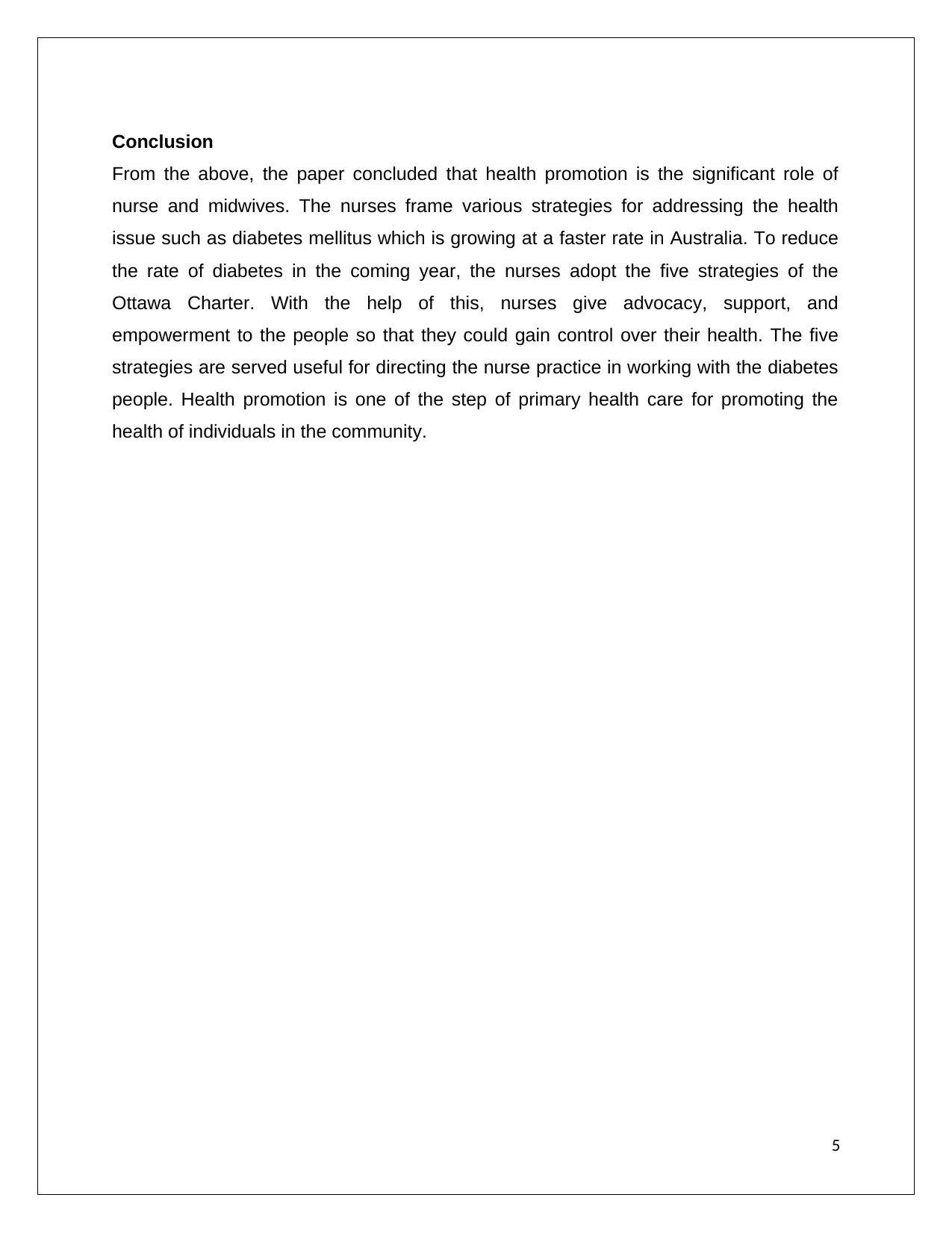
Conclusion
From the above, the paper concluded that health promotion is the significant role of
nurse and midwives. The nurses frame various strategies for addressing the health
issue such as diabetes mellitus which is growing at a faster rate in Australia. To reduce
the rate of diabetes in the coming year, the nurses adopt the five strategies of the
Ottawa Charter. With the help of this, nurses give advocacy, support, and
empowerment to the people so that they could gain control over their health. The five
strategies are served useful for directing the nurse practice in working with the diabetes
people. Health promotion is one of the step of primary health care for promoting the
health of individuals in the community.
5
From the above, the paper concluded that health promotion is the significant role of
nurse and midwives. The nurses frame various strategies for addressing the health
issue such as diabetes mellitus which is growing at a faster rate in Australia. To reduce
the rate of diabetes in the coming year, the nurses adopt the five strategies of the
Ottawa Charter. With the help of this, nurses give advocacy, support, and
empowerment to the people so that they could gain control over their health. The five
strategies are served useful for directing the nurse practice in working with the diabetes
people. Health promotion is one of the step of primary health care for promoting the
health of individuals in the community.
5
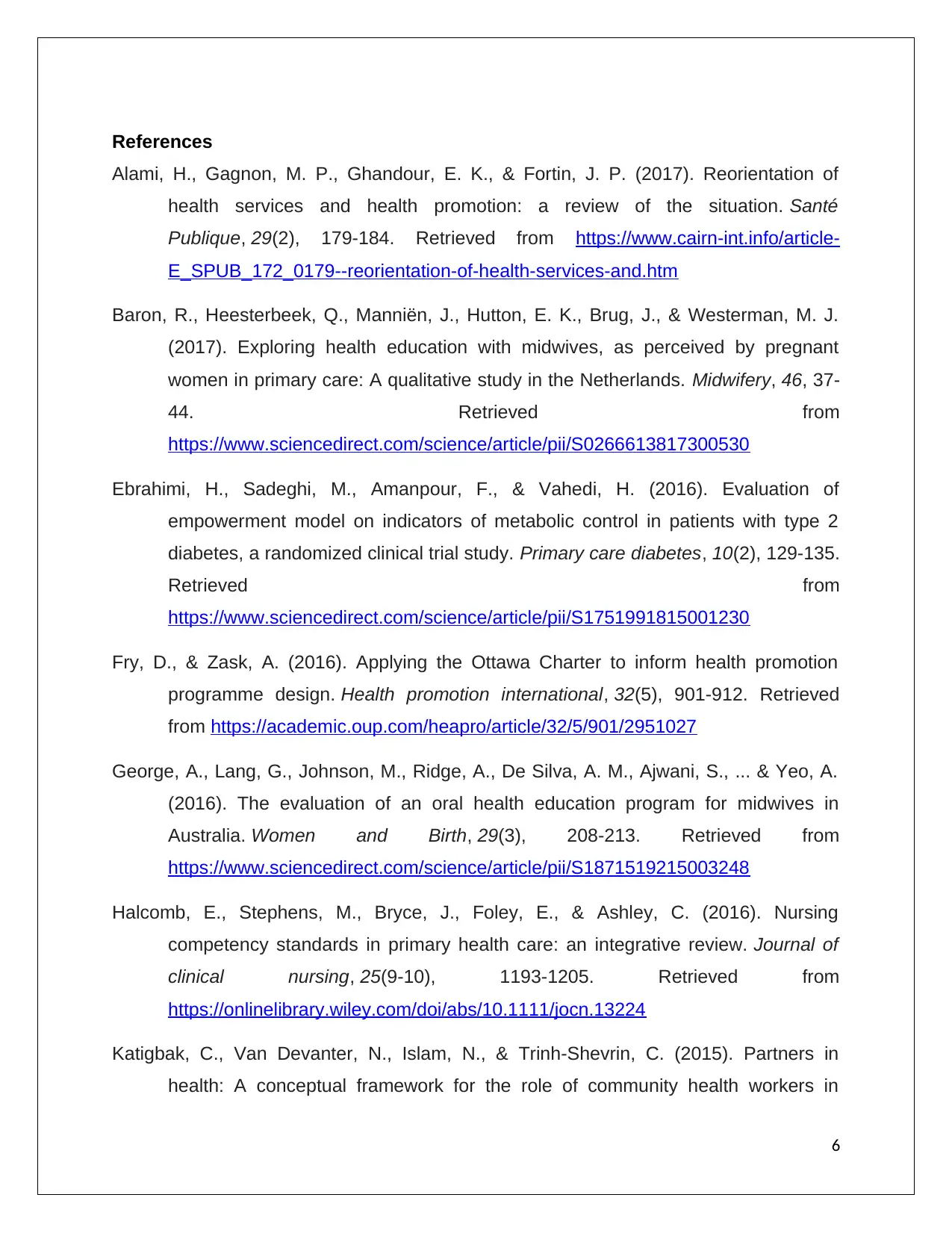
References
Alami, H., Gagnon, M. P., Ghandour, E. K., & Fortin, J. P. (2017). Reorientation of
health services and health promotion: a review of the situation. Santé
Publique, 29(2), 179-184. Retrieved from https://www.cairn-int.info/article-
E_SPUB_172_0179--reorientation-of-health-services-and.htm
Baron, R., Heesterbeek, Q., Manniën, J., Hutton, E. K., Brug, J., & Westerman, M. J.
(2017). Exploring health education with midwives, as perceived by pregnant
women in primary care: A qualitative study in the Netherlands. Midwifery, 46, 37-
44. Retrieved from
https://www.sciencedirect.com/science/article/pii/S0266613817300530
Ebrahimi, H., Sadeghi, M., Amanpour, F., & Vahedi, H. (2016). Evaluation of
empowerment model on indicators of metabolic control in patients with type 2
diabetes, a randomized clinical trial study. Primary care diabetes, 10(2), 129-135.
Retrieved from
https://www.sciencedirect.com/science/article/pii/S1751991815001230
Fry, D., & Zask, A. (2016). Applying the Ottawa Charter to inform health promotion
programme design. Health promotion international, 32(5), 901-912. Retrieved
from https://academic.oup.com/heapro/article/32/5/901/2951027
George, A., Lang, G., Johnson, M., Ridge, A., De Silva, A. M., Ajwani, S., ... & Yeo, A.
(2016). The evaluation of an oral health education program for midwives in
Australia. Women and Birth, 29(3), 208-213. Retrieved from
https://www.sciencedirect.com/science/article/pii/S1871519215003248
Halcomb, E., Stephens, M., Bryce, J., Foley, E., & Ashley, C. (2016). Nursing
competency standards in primary health care: an integrative review. Journal of
clinical nursing, 25(9-10), 1193-1205. Retrieved from
https://onlinelibrary.wiley.com/doi/abs/10.1111/jocn.13224
Katigbak, C., Van Devanter, N., Islam, N., & Trinh-Shevrin, C. (2015). Partners in
health: A conceptual framework for the role of community health workers in
6
Alami, H., Gagnon, M. P., Ghandour, E. K., & Fortin, J. P. (2017). Reorientation of
health services and health promotion: a review of the situation. Santé
Publique, 29(2), 179-184. Retrieved from https://www.cairn-int.info/article-
E_SPUB_172_0179--reorientation-of-health-services-and.htm
Baron, R., Heesterbeek, Q., Manniën, J., Hutton, E. K., Brug, J., & Westerman, M. J.
(2017). Exploring health education with midwives, as perceived by pregnant
women in primary care: A qualitative study in the Netherlands. Midwifery, 46, 37-
44. Retrieved from
https://www.sciencedirect.com/science/article/pii/S0266613817300530
Ebrahimi, H., Sadeghi, M., Amanpour, F., & Vahedi, H. (2016). Evaluation of
empowerment model on indicators of metabolic control in patients with type 2
diabetes, a randomized clinical trial study. Primary care diabetes, 10(2), 129-135.
Retrieved from
https://www.sciencedirect.com/science/article/pii/S1751991815001230
Fry, D., & Zask, A. (2016). Applying the Ottawa Charter to inform health promotion
programme design. Health promotion international, 32(5), 901-912. Retrieved
from https://academic.oup.com/heapro/article/32/5/901/2951027
George, A., Lang, G., Johnson, M., Ridge, A., De Silva, A. M., Ajwani, S., ... & Yeo, A.
(2016). The evaluation of an oral health education program for midwives in
Australia. Women and Birth, 29(3), 208-213. Retrieved from
https://www.sciencedirect.com/science/article/pii/S1871519215003248
Halcomb, E., Stephens, M., Bryce, J., Foley, E., & Ashley, C. (2016). Nursing
competency standards in primary health care: an integrative review. Journal of
clinical nursing, 25(9-10), 1193-1205. Retrieved from
https://onlinelibrary.wiley.com/doi/abs/10.1111/jocn.13224
Katigbak, C., Van Devanter, N., Islam, N., & Trinh-Shevrin, C. (2015). Partners in
health: A conceptual framework for the role of community health workers in
6
Paraphrase This Document
Need a fresh take? Get an instant paraphrase of this document with our AI Paraphraser
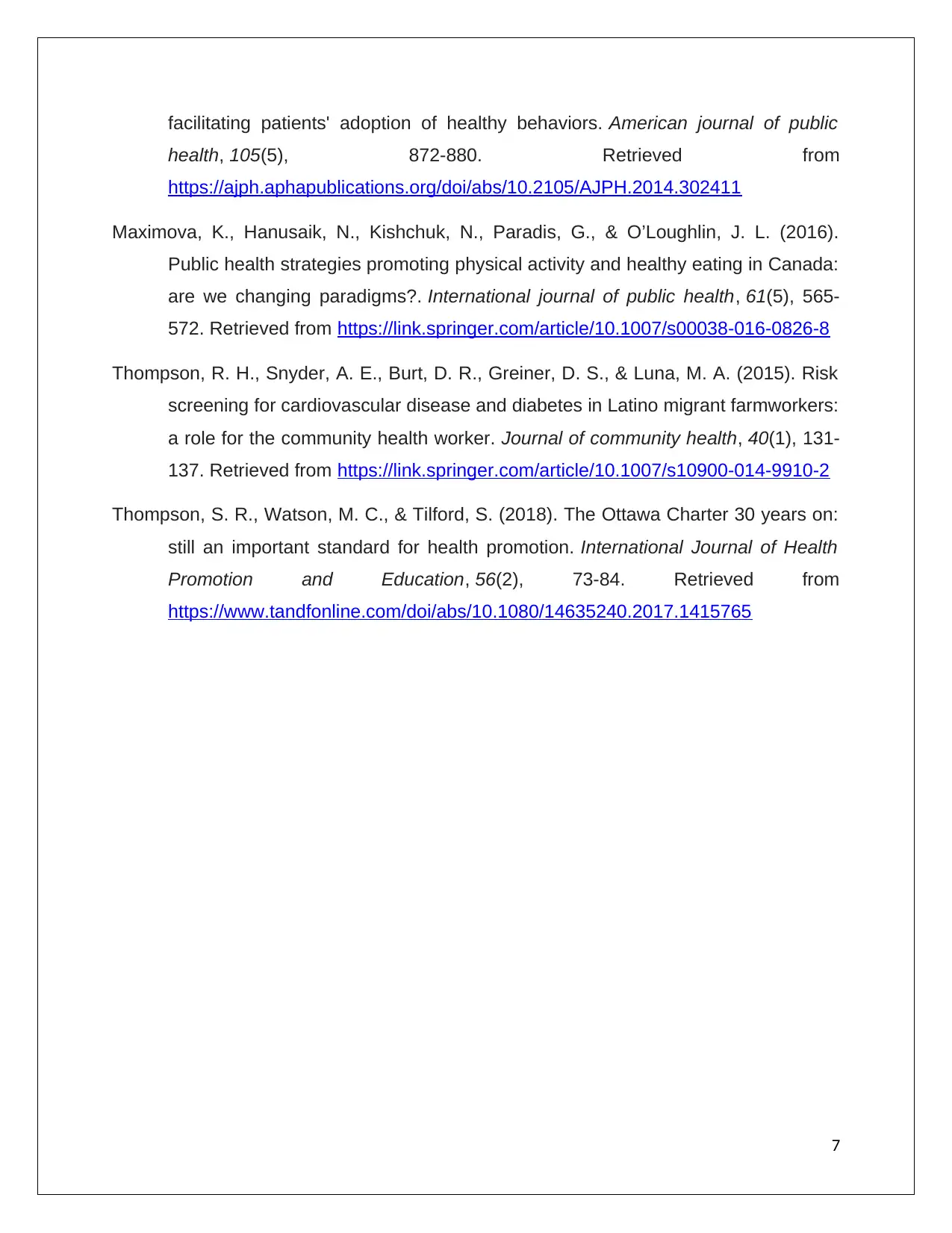
facilitating patients' adoption of healthy behaviors. American journal of public
health, 105(5), 872-880. Retrieved from
https://ajph.aphapublications.org/doi/abs/10.2105/AJPH.2014.302411
Maximova, K., Hanusaik, N., Kishchuk, N., Paradis, G., & O’Loughlin, J. L. (2016).
Public health strategies promoting physical activity and healthy eating in Canada:
are we changing paradigms?. International journal of public health, 61(5), 565-
572. Retrieved from https://link.springer.com/article/10.1007/s00038-016-0826-8
Thompson, R. H., Snyder, A. E., Burt, D. R., Greiner, D. S., & Luna, M. A. (2015). Risk
screening for cardiovascular disease and diabetes in Latino migrant farmworkers:
a role for the community health worker. Journal of community health, 40(1), 131-
137. Retrieved from https://link.springer.com/article/10.1007/s10900-014-9910-2
Thompson, S. R., Watson, M. C., & Tilford, S. (2018). The Ottawa Charter 30 years on:
still an important standard for health promotion. International Journal of Health
Promotion and Education, 56(2), 73-84. Retrieved from
https://www.tandfonline.com/doi/abs/10.1080/14635240.2017.1415765
7
health, 105(5), 872-880. Retrieved from
https://ajph.aphapublications.org/doi/abs/10.2105/AJPH.2014.302411
Maximova, K., Hanusaik, N., Kishchuk, N., Paradis, G., & O’Loughlin, J. L. (2016).
Public health strategies promoting physical activity and healthy eating in Canada:
are we changing paradigms?. International journal of public health, 61(5), 565-
572. Retrieved from https://link.springer.com/article/10.1007/s00038-016-0826-8
Thompson, R. H., Snyder, A. E., Burt, D. R., Greiner, D. S., & Luna, M. A. (2015). Risk
screening for cardiovascular disease and diabetes in Latino migrant farmworkers:
a role for the community health worker. Journal of community health, 40(1), 131-
137. Retrieved from https://link.springer.com/article/10.1007/s10900-014-9910-2
Thompson, S. R., Watson, M. C., & Tilford, S. (2018). The Ottawa Charter 30 years on:
still an important standard for health promotion. International Journal of Health
Promotion and Education, 56(2), 73-84. Retrieved from
https://www.tandfonline.com/doi/abs/10.1080/14635240.2017.1415765
7
1 out of 8
Related Documents
Your All-in-One AI-Powered Toolkit for Academic Success.
+13062052269
info@desklib.com
Available 24*7 on WhatsApp / Email
![[object Object]](/_next/static/media/star-bottom.7253800d.svg)
Unlock your academic potential
© 2024 | Zucol Services PVT LTD | All rights reserved.





